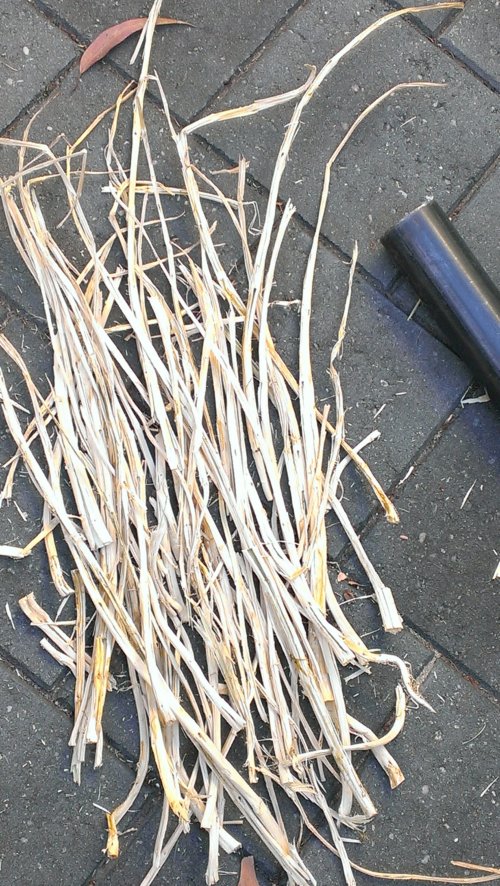Finally, I returned to the harvested and then twice retted nettle stems. I began by rolling a pipe over them to make the stems easier to split.
I have been putting this task off because these stems looked so little promising.
The stems mostly shattered without fibre becoming evident in any significant way.
I gathered just a little fibre for a lot of effort.
After carding, I was left with this. So I cleaned my handcards on the garden, added the stems to the mulch in the garden, and now… I wait for next year!
A belated postscript: there is a wonderful community flax growing project reaching the spinning stage on the other side of the planet. So for stories of bast fibre success, please go to visit Sharon Kallis here.






I think you are very persistent.
Are the stems supposed to be this dry and brittle when you separate the fibers?
LikeLike
Thanks, Pia! The short answer is that I don’t know. Clearly there are parts of this process I simply haven’t grasped yet. But the books and online materials I have read and seen all seem to me to suggest that the stems are dried after retting. It seems likely to me that I retted too long or not long enough–but I was impressed by the slender stems and the thick ones all giving little fibre.
LikeLike
Yes, persistent, and patient! I’ve tried getting nettle fibres when I studied the late stone ages, but all I could manage was a small piece of very thin rope 🙂 This website has nice photos, but the text is in German: http://tarmes.at/projekt-urtica/ He talks about rotting as a process of drying and wetting, drying and wetting over several weeks. Not like flax, which is just wetted. Anyway – I admire your determination.
LikeLike
Congratulations on a thin piece of rope. I’d be delighted if I managed that much 🙂
There are several different means of retting. Some, dew retting, in particular, involve drying and wetting repeatedly, while others involve submersion. I tried the submersion type, since dew isn’t terribly plentiful here. After the first submersion, a couple of commenters suggested maybe I hadn’t retted long enough, so back into the tub with my stems for another three days. perhaps that still wasn’t enough! I’m off to look at the photos (my German won’t get me far).
LikeLike
Those pictures are so interesting, thanks for the link. The use of the mallet as a brake is a promising low-fi approach using tools I can access. Interesting that the fibres go into what looks like a pan of water at the end–I am not sure if this is a bleaching process or an effort to remove undesired plant material. The German nettles look much greener/browner than mine. Which may mean I over-retted mine… or that there is regional variation and mine are simply a different colour. So many things that are unknown–to me, at least!
LikeLike
I looked at the pics and read the text again – the guy doesn’t explain the pot at the end. However, he does mention a method used in Nepal where apparently they have a large nettle, girardinia diversifolia (Himalayan Giant Nettle). It is harvested, the leaves taken off, and the stems peeled. Then they’re simmered over night in a bath of water and wood ash (the water is later used as a fertiliser). Next day, the fibres are beaten against stones and rubbed with damp clay to remove the woody pieces.
Large stems and wood ash might be the key to success for the very persistent …
In my course we didn’t do that, we only did the wetting, drying etc. And the piece of rope was VERY SHORT indeed!
LikeLike
Thanks for that extra detail! Who knows… maybe next year I’ll do better? It seems like I am accumulating new information each time, but only being able to practise once a year isn’t improving my skills and judgment at a very fast rate.
LikeLike
I sympathise. I have no experience with retting nettles so can’t really offer any advice except….. keep trying, it’s all an experiment. I’m grappling with the same issue with flax, and right now am hoping that I’ve judged the retting stage right. I’ve been checking on it, picking up a small bunch and trying to ‘break’ a little by hand. I’ve just posted about it. What I didn’t mention was that when leaving the flax to dry before retting I left a couple of bunches outside. They fell over and retted of their own accord. By the time I found them they were completely over retted (just broke apart) so that lot ended up on the compost – mistake No 1. I hope you have more success next time. Nettles really get a hold on my own allotment, and quite tall – about as tall as you mentioned in your earlier post. If you weren’t on the other side of the globe, I’d happily send you some! I haven’t experimented with them yet.
LikeLike
Thanks for the post where you documented the project you’re involved in. To me it looks very successful, and that’s a great post! I wish I could take up your offer of nettles. Experimenting once a year isn’t moving my skills on very fast 🙂
LikeLike